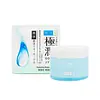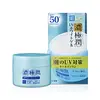What's inside
What's inside
 Key Ingredients
Key Ingredients

 Benefits
Benefits

 Concerns
Concerns

 Ingredients Side-by-side
Ingredients Side-by-side

Water
Skin ConditioningAlcohol
AntimicrobialGlycerin
HumectantNiacinamide
SmoothingButylene Glycol
HumectantDimethicone
Emollient1,2-Hexanediol
Skin ConditioningIsononyl Isononanoate
EmollientAcrylates/C10-30 Alkyl Acrylate Crosspolymer
Emulsion StabilisingPhenoxyethanol
PreservativeTromethamine
BufferingEthylhexylglycerin
Skin ConditioningDimethiconol
EmollientBetaine
HumectantXanthan Gum
EmulsifyingAdenosine
Skin ConditioningHydrogenated Lecithin
EmulsifyingTocopheryl Acetate
AntioxidantSodium Hyaluronate
HumectantPiper Methysticum Leaf/Root/Stem Extract
Skin ConditioningPhellinus Linteus Extract
Skin ConditioningHydrolyzed Hyaluronic Acid
HumectantArctium Lappa Root Extract
Skin ConditioningCitrus Medica Peel Oil
Soluble Collagen
HumectantPortulaca Oleracea Extract
Skin ConditioningPanthenol
Skin ConditioningCitrus Grandis Peel Oil
MaskingCitrus Aurantium Bergamia Fruit Oil
MaskingCitrus Aurantium Dulcis Peel Oil
MaskingPueraria Thunbergiana Root Extract
Skin ConditioningPaeonia Lactiflora Root Extract
Skin ConditioningGlycyrrhiza Glabra Root Extract
BleachingCnidium Officinale Root Extract
Skin ConditioningAloe Barbadensis Leaf Juice
Skin ConditioningHydrogenated Phosphatidylcholine
EmulsifyingRaffinose
Skin ConditioningIsostearyl Isostearate
EmollientPelargonium Graveolens Flower Oil
MaskingCholesterol
EmollientCeramide NP
Skin ConditioningFolic Acid
Skin ConditioningTocopheryl Linoleate
AntioxidantSodium Acetylated Hyaluronate
HumectantPotassium Cetyl Phosphate
EmulsifyingInulin Lauryl Carbamate
Emulsion StabilisingCedrus Atlantica Bark Oil
MaskingCananga Odorata Flower Oil
MaskingIllicium Verum Fruit/Seed Oil
MaskingCymbopogon Nardus Oil
MaskingEugenia Caryophyllus Leaf Oil
MaskingCI 42090
Cosmetic ColorantAnthemis Nobilis Flower Oil
MaskingJasminum Officinale Oil
MaskingSantalum Album Oil
MaskingFerula Galbaniflua Resin Oil
AntimicrobialRose Flower Oil
MaskingPalmitoyl Pentapeptide-4
Skin ConditioningWater, Alcohol, Glycerin, Niacinamide, Butylene Glycol, Dimethicone, 1,2-Hexanediol, Isononyl Isononanoate, Acrylates/C10-30 Alkyl Acrylate Crosspolymer, Phenoxyethanol, Tromethamine, Ethylhexylglycerin, Dimethiconol, Betaine, Xanthan Gum, Adenosine, Hydrogenated Lecithin, Tocopheryl Acetate, Sodium Hyaluronate, Piper Methysticum Leaf/Root/Stem Extract, Phellinus Linteus Extract, Hydrolyzed Hyaluronic Acid, Arctium Lappa Root Extract, Citrus Medica Peel Oil, Soluble Collagen, Portulaca Oleracea Extract, Panthenol, Citrus Grandis Peel Oil, Citrus Aurantium Bergamia Fruit Oil, Citrus Aurantium Dulcis Peel Oil, Pueraria Thunbergiana Root Extract, Paeonia Lactiflora Root Extract, Glycyrrhiza Glabra Root Extract, Cnidium Officinale Root Extract, Aloe Barbadensis Leaf Juice, Hydrogenated Phosphatidylcholine, Raffinose, Isostearyl Isostearate, Pelargonium Graveolens Flower Oil, Cholesterol, Ceramide NP, Folic Acid, Tocopheryl Linoleate, Sodium Acetylated Hyaluronate, Potassium Cetyl Phosphate, Inulin Lauryl Carbamate, Cedrus Atlantica Bark Oil, Cananga Odorata Flower Oil, Illicium Verum Fruit/Seed Oil, Cymbopogon Nardus Oil, Eugenia Caryophyllus Leaf Oil, CI 42090, Anthemis Nobilis Flower Oil, Jasminum Officinale Oil, Santalum Album Oil, Ferula Galbaniflua Resin Oil, Rose Flower Oil, Palmitoyl Pentapeptide-4
Water
Skin ConditioningEthylhexyl Methoxycinnamate
UV AbsorberIsononyl Isononanoate
EmollientDimethicone
EmollientAlcohol Denat.
AntimicrobialButylene Glycol
HumectantPEG-12 Dimethicone
Skin ConditioningPentylene Glycol
Skin ConditioningPolysilicone-15
UV FilterGlycol Dimethacrylate Crosspolymer
Bis-Ethylhexyloxyphenol Methoxyphenyl Triazine
Skin ConditioningHydrolyzed Hyaluronic Acid
HumectantSodium Hyaluronate
HumectantDiethylamino Hydroxybenzoyl Hexyl Benzoate
UV FilterPolysilicone-13
Phenoxyethanol
PreservativeCarbomer
Emulsion StabilisingMelaleuca Alternifolia Leaf Oil
AntioxidantPolystyrene
Polyvinyl Alcohol
Hydroxyethylcellulose
Emulsion StabilisingDisodium EDTA
Iodopropynyl Butylcarbamate
PreservativeAcrylates/C10-30 Alkyl Acrylate Crosspolymer
Emulsion StabilisingTitanium Dioxide
Cosmetic ColorantAmmonium Acrylates Copolymer
Silica
AbrasiveAluminum Hydroxide
EmollientHydrogen Dimethicone
Methylparaben
PreservativeWater, Ethylhexyl Methoxycinnamate, Isononyl Isononanoate, Dimethicone, Alcohol Denat., Butylene Glycol, PEG-12 Dimethicone, Pentylene Glycol, Polysilicone-15, Glycol Dimethacrylate Crosspolymer, Bis-Ethylhexyloxyphenol Methoxyphenyl Triazine, Hydrolyzed Hyaluronic Acid, Sodium Hyaluronate, Diethylamino Hydroxybenzoyl Hexyl Benzoate, Polysilicone-13, Phenoxyethanol, Carbomer, Melaleuca Alternifolia Leaf Oil, Polystyrene, Polyvinyl Alcohol, Hydroxyethylcellulose, Disodium EDTA, Iodopropynyl Butylcarbamate, Acrylates/C10-30 Alkyl Acrylate Crosspolymer, Titanium Dioxide, Ammonium Acrylates Copolymer, Silica, Aluminum Hydroxide, Hydrogen Dimethicone, Methylparaben
 Reviews
Reviews

Ingredients Explained
These ingredients are found in both products.
Ingredients higher up in an ingredient list are typically present in a larger amount.
Acrylates/C10-30 Alkyl Acrylate Crosspolymer is a synthetic polymer. It is used to thicken and improve the texture of products. Due to its properties, it can prevent water and oil ingredients from separating.
Butylene Glycol (or BG) is used within cosmetic products for a few different reasons:
Overall, Butylene Glycol is a safe and well-rounded ingredient that works well with other ingredients.
Though this ingredient works well with most skin types, some people with sensitive skin may experience a reaction such as allergic rashes, closed comedones, or itchiness.
Learn more about Butylene GlycolDimethicone is a type of synthetic silicone created from natural materials such as quartz.
What it does:
Dimethicone comes in different viscosities:
Depending on the viscosity, dimethicone has different properties.
Ingredients lists don't always show which type is used, so we recommend reaching out to the brand if you have questions about the viscosity.
This ingredient is unlikely to cause irritation because it does not get absorbed into skin. However, people with silicone allergies should be careful about using this ingredient.
Note: Dimethicone may contribute to pilling. This is because it is not oil or water soluble, so pilling may occur when layered with products. When mixed with heavy oils in a formula, the outcome is also quite greasy.
Learn more about DimethiconeHydrolyzed Hyaluronic Acid is a form of hyaluronic acid. It is created by the hydrolysis of hyaluronic acid with a high molecular weight. Once created, Hydrolyzed Hyaluronic Acid has a low molecular weight.
Low molecular weight HA has been shown to hydrate and increase elasticity of the skin. Increasing elasticity is also associated with reduction of wrinkle depth.
One study found topical low molecular weight hyaluronic acid may be considered for the treatment of rosacea in the adult population. However, we always recommend speaking with a professional about your skin concerns.
Hyaluronic acids are a humectant. This means they draw moisture from the air. Hyaluronic acids help moisturize, soothe, and protect the skin.
Read more about other common forms of hyaluronic acid:
Learn more about Hydrolyzed Hyaluronic AcidIsononyl Isononanoate is a synthetic skin-conditioner and texture enhancer. It is created from nonanoic acid, a fatty acid found in cocoa and lavender oil.
As an emollient, Isononyl Isononanoate helps keep your skin soft and smooth. This is because emollients create a barrier on the skin to trap moisture in.
Isononyl Isononanoate helps give products a velvet feel and improves spreadability.
Learn more about Isononyl IsononanoatePhenoxyethanol is a preservative that has germicide, antimicrobial, and aromatic properties. Studies show that phenoxyethanol can prevent microbial growth. By itself, it has a scent that is similar to that of a rose.
It's often used in formulations along with Caprylyl Glycol to preserve the shelf life of products.
Sodium Hyaluronate is hyaluronic acid's salt form. It is commonly derived from the sodium salt of hyaluronic acid.
Like hyaluronic acid, it is great at holding water and acts as a humectant. This makes it a great skin hydrating ingredient.
Sodium Hyaluronate is naturally occurring in our bodies and is mostly found in eye fluid and joints.
These are some other common types of Hyaluronic Acid:
Learn more about Sodium HyaluronateWater. It's the most common cosmetic ingredient of all. You'll usually see it at the top of ingredient lists, meaning that it makes up the largest part of the product.
So why is it so popular? Water most often acts as a solvent - this means that it helps dissolve other ingredients into the formulation.
You'll also recognize water as that liquid we all need to stay alive. If you see this, drink a glass of water. Stay hydrated!
Learn more about Water